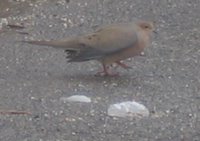Our first snowstorm of the year - and maybe the second of the winter - has begun, and it may dump quite a lot. The rain that had been falling for most of the day changed over to snow here between 4 and 5 pm. It is supposed to intensify overnight and end in the morning. When I was out a little earlier, the snow was coming down almost horizontally since there is a steady northeasterly wind blowing. The salt trucks have already made their rounds.
I really do not mind mild weather, but I do like to get at least some snow over the course of the winter. Otherwise it does not feel like a real winter. Maybe I should live farther north.
Update (10:30 pm): The Post is working on hyping the storm:
Winter reasserted itself over metropolitan Washington yesterday in the form of a powerful nor'easter that was forecast to yield the region's heaviest snow in three years....
The storm formed Friday over the Gulf of Mexico and swung into the deep South, bringing thunder to Alabama and Georgia and snow to the mountains of North Carolina and Tennessee. It was forecast to bring a total of six to 12 inches of snow to the Washington region, a bit less toward the Atlantic coast and in Western Maryland.
The coverage seems to emphasize the high end of that, but I have a hard time seeing us getting that much snow. A foot is a pretty rare event around here. And at least on my street, the snow is still barely sticking to the pavement and other hard surfaces.
Update (midnight): The snow began falling with a lot more conviction in the past hour or so. There is now a white coating on the street and even a small accumulation on the roof outside my window.
Capital Weather has been revising its snowfall predictions downward throughout the evening.
Update (8 am): The
Post is reporting that National Airport measured 8 inches of snow overnight, but that some areas north of the city - like Columbia, MD - received 20 inches. I see about 3 inches on the roof outside my window; that means the accumulation around here will be somewhat more than that because snow usually takes longer to stick there than on grass or even the sidewalk.
Here are some house sparrows outside my window.

Update (10:30 am): There is an eight-inch blanket of snow on the ground around my neighborhood. Here are some more pictures of the fresh snow.



And finally, here is a crow, to keep at least some birds in the picture.

It looks like New York City got about
two feet of snow, and possibly more. The ski resort owners seem very happy about that.












































